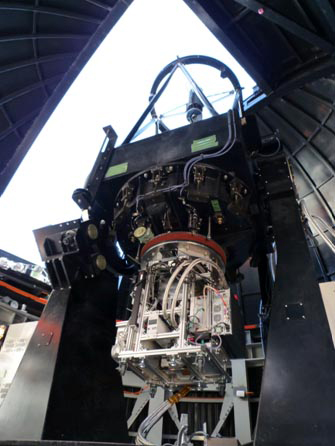
|
TAO Project |
|
The TAO project

|
1m TelescopePrior to the construction of the 6.5-m TAO telescope, we built a 1-m miniTAO telescope at the summit of Mt. Chajnantor, to provide first light observations using an optical CCD camera for engineering studies in March, 2009. Then, in June of the same year, we mounted the ANIR near-infrared camera on the 1-m telescope and succeeded in obtaining an image toward the central region of the Milky Way galaxy in the near-infrared hydrogen emission line of Paα (1.875µm), a first for a ground-based telescope. We mounted the MAX38 mid-infrared camera on the telescope in November of the same year, and succeeded in carrying out observations at a wavelength of 38μm from the ground for the first time. We will continue to observe a wide variety of targets in the future.
ANIR
|
||||||||

|
| ▲ The 1-m miniTAO telescope and the near-infrared camera ANIR. The black-colored structure is the telescope, and the structure below the red disk is the ANIR. |
Mounted on the miniTAO telescope in June 2009, we succeeded
in imaging the structure near the Galactic center revealed by
the near-infrared hydrogen emission line of Paα (1.875µm).
This was the first observation of Paα emission line
from a ground-based telescope.
http://www.ioa.s.u-tokyo.ac.jp/TAO/press/pressrelease20090702/top.html
http://www.s.u-tokyo.ac.jp/press/press-2009-15.html
More details for the ANIR are described below
- The Atacama NIR Camera Wiki (English)
- The engineering first light of the ANIR and the test observation by the MAX38 in Higashi-Hiroshima Observatory in February 2008
MAX38
(Mid-infrared Astronomical eXplorer 38)
The mid-infrared camera MAX38 (Mid-infrared Astronomical eXplorer 38) when mounted on the 1-m miniTAO telescope at the summit of Mt. Chajnantor, is capable of observing in thermal infrared wavelengths (20-30µm).

|
| ▲ The 1-m miniTAO telescope and the mid-infrared camera MAX38. The structure below the red disk is the MAX38. |
The atmospheric absorption in the thermal mid-infrared is so
strong that observations from ground-based telescopes
have been impossible.
However, in November 2009, we succeeded
in measuring
38μm emission from the ground for the first time.
http://www.ioa.s.u-tokyo.ac.jp/TAO/press/pressrelease200912/top.html
http://www.s.u-tokyo.ac.jp/press/press-2009-30.html
More details for MAX38 are described below.
- The MAX38 web (English)
- The engineering first light of the MAX38 in Higashi-Hiroshima Observatory,
in May 2007
- The engineering first light of the ANIR and the test observation by the MAX38 in Higashi-Hiroshima Observatory, in February 2008